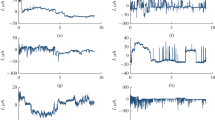Conclusions
The distribution of the galvanometer's moving-coil fluctuation energy with respect to frequency depends only on the total damping intensity of the coil.
The variance of these fluctuations does not depend on which of the above effects produces them. The share contributed to the variance of fluctuations by each effect is proportional to the ratio of each of their damping co-efficients to the total damping coefficient of the galvanometer coil.
Similar content being viewed by others
Literature cited
L. D. Landau and E. M. Livshits, Statistical Physics [in Russian], Nauka, Moscow (1964).
V. O. Arutyunov, Electrical Measuring Instruments and Measurements [in Russian], GÉI Moscow (1958).
Additional information
Translated from Izmeritel'naya Tekhnika, No. 10, pp. 41–42, October, 1969.
Rights and permissions
About this article
Cite this article
Troitskii, E.A. Natural fluctuations of galvanometer moving parts. Meas Tech 12, 1387–1389 (1969). https://doi.org/10.1007/BF00994860
Received:
Issue Date:
DOI: https://doi.org/10.1007/BF00994860




